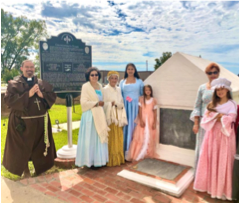- Dr. Miller
- Jun 11, 2020
- 6 min read
Updated: Jun 13, 2020
How does a fish know that it is wet?
This was the thought that formed in my mind, as I traveled, silently, smoothly, twistingly down the cool path of the Bayou Teche.
Although I had been on a boat only a few times in my life, and my 10 year-old goddaughter, Marie, only once, there was something almost natural, soothing, something that fit as we made our way down the bayou with the Fête-Dieu du Teche, celebrating the arrivals of the Cajuns to southern Louisiana on our feast day, the Feast of the Assumption.
With every other culture that I had experienced so far, the nations of the Oglala Lakota, the Northern Cheyenne, and the Crow, and my time in Mexico, it had been clear that this was a new culture, a culture to be explored, a culture where hidden treasures awaited me at every turn.
Yet, here in my own culture, it felt normal to be part of a boat-led Eucharistic procession. If my own culture is instinctual, I worried and wondered, how can I discover the hidden treasures? If I have grown up with “jambalaya, crawfish pie, and filé gumbo,” if I think song lyrics like, “Don’t Mess with my Toot Toot,” are normal, how will I know what is particular to being Cajun?

Photo courtesy of Heather Guy, amateur photographer
Almost two months later, on the opening day of the Festivals Acadiens et Créoles, I began to understand the answer.
A priest friend, excited that I would be doing research in our home diocese, contacted me to let me know that the Festival this year would be focusing on “Les femmes et les filles: Female Perspectives in Cajun and Creole Culture.” Kristi Guillory Munzing, a friend of his and founder of Bonsoir, Catin, an all-female Cajun band, was a speaker at a panel on female Cajun perspectives, and their band would be leading the fais do-do, or music and dancing, of the Festival itself.
Sitting in on the panel, listening to Dr. Barry Ancelet, Wade Falcon, and Kristi Munzing discuss such Cajun classics as Jolie Blonde, who she was, why she left, the new life that she found, I realized there was so about my culture I didn’t know. How could this song and the woman it praised generate so much discussion, and I wasn’t even aware of its existence? Was there a “hidden treasure” here? And yet, my ignorance of these elements of my culture is part of the Cajun experience as a whole.
When the Cajuns were forcibly exiled from Nova Scotia in 1755, many of them had made their way to Louisiana, where they were able to maintain the tight-knit community that had distinguished them since their departure from France in the 16th century. French-speaking, hard-working people, close to the water and the land, characterized by a reliance on divine Providence that was made explicit in their fidelity to the Catholic faith, they maintained that culture for centuries, as the country around them changed: from Spanish territory, to French, and then to American, after Napoleon sold it cheaply to the United States in 1803.
When, in 1916, English was imposed as the language of education, young Cajun children were denied the right to speak their own language on school grounds and often beaten or mocked as ignorant if they did so.
The Cajuns, who had preserved their language, their faith, and their music were in danger of being assimilated. While my great-grandparents, and even some of my grandparents, still spoke Cajun fluently, my parents only had English spoken to them at home, and my generation often only has a word here or there, thrown into conversation: someone has an envie, or desire, for ice cream, a mal de tête when their head hearts, and “sha,” the equivalent of “cher” or dear one, is a necessary exclamation over everyone’s baby! Yet, these were only bits and pieces of the heritage.

Beautifully enough, it was the music festivals of the 1960s that began to help Cajuns to once more embrace a sense of pride in their culture. Bringing their music and dancing out into the public space brought about a new sense of self-awareness. In our interview, Dr. Barry Ancelet, Cajun folklorist and founder of the Festivals Acadiens et Créoles, recounted how at the first Festival in 1974, they had the police keep the Cajuns and Creoles from dancing. He explained, “Dewey Balfa and Richard Guidry said, ‘If they're dancing, they won't be paying attention. You got to sit them down and force them to pay attention in a new way.’” So in the packed Blackham Coliseum, the people of Acadiana filled the 8400 seats, standing and sitting in the back and in every available corner, as well over 10,000 of them experienced their culture in a new way.
From left to right: The Magnolia Sisters, one of the early all-women Cajun bands, photo courtesy of Dr. Ancelet; Henry Hample, fiddler, and Jamie and Madeline Berzas of the contemporary The Cajun Tradition Band, photo by Dave Simpson (full disclosure: Jamie Berzas is my parrain, or godfather, of whom I am very proud!); and Bonsoir, Catin, contemporary all-women Cajun band, photo courtesy of Dr. Ancelet.
Celebrating French-rooted culture in southern Louisiana, seeking to preserve and live their cultural treasures, is also fundamental to the life of their Creole cousins. Hence, at the invitation of Dr. Mark Guidry, president of the St. Augustine Historical Society, I made the trip with my sister, Nicole Ortego, fellow theologian and amateur historian, to Natchitoches and the unincorporated community of Isle Brevelle along Cane River. The community is centered around St. Augustine Catholic Church, which began as a plantation chapel in 1803 on the property of the community founder, Nicolas Augustin Metoyer (1768-1856), still affectionately referred to as “Grandpere” today. Grandpere Augustin was the first of ten children of the Frenchman, Claude “Grandpere Thomas” Metoyer, and a former slave who later became one of the wealthiest free women in Louisiana, “Meme Thereze,” Marie Thereze (dit Coincoin). Today, most but not all, parishioners of St. Augustine Catholic Church are descendants of this early Metoyer and still live on the same land, preserving the church and heritage that Grandpere built.

The photo on the right is from the dedication of the 1770s Badin Roque House being placed on the National Registry of Historical Places in 1979. Pictured are the Metoyer descendants who were the founding members of the historical society with their pastor, Father Francis Smith of the St. Augustine Historical Society. Photos courtesy of Dr. Mark Guidry.
It was here that Nicole and I sat and spoke in their home with PJ and Rebecca Metoyer Jones, learning about the differences and similarities between Cajun and Creole culture – gumbo fitting into both of those categories! - and then the next day, Tommy and Kathie Sarpy Roque had me over for dinner. Throughout both interviews, the couples highlighted the strength of Creole bonds and pride in one’s family.
As Rebecca proudly recounted, “[T]o be a Creole woman, it's amazing. It means family, it means tradition, it means culture…our family ties are so big…I love how our families stick together and that we do everything for one another.” She and PJ laughed about how family called to use their home for a barbecue – and so the house was opened and a barbecue was had – while she and Patrick were hours away in New Orleans! Rebecca spoke also of how their children were growing into this family heritage, “My daughter just did research on…how the Zydeco came about, because of the Creoles…after harvest season, they came in together for fellowship and family. They cooked, and they had a big party in their houses. And…they would sit there and play the instruments, that brought about the Zydeco music…”
Members of the St. Augustine Historical Society regularly perform historical re-enactments and tours for outside groups and during the annual Church fair - an event when descendants who live throughout the country return “home” as a national pilgrimage. Photos courtesy of Dr. Mark Guidry.
Tommy and Kathie spoke after our dinner about the importance of the annual Church fair, where Creoles who have moved all over the United States – Texas, California, Chicago – come back to gather as a family, their work to maintain the family land, and the St. Augustine Historical Society, which is allowing them to grow in knowledge and pride of the Metoyer family and their roots.

Driving back home from the weekend in Cane River, with a chest full of meat pies and tamales that Mark and the Roques had insisted I take back home to my family, thinking through the interviews in Acadiana, I realized that the answer to my question, “How does a fish know it is wet?” was somehow found in the experience of my own people. Like a fish seeking to understand water, or even better, like a crawfish who has become comfortable with both the land and the water, Cajuns and Creoles, like women and men in every culture, are called to dive deeper, to discuss together their everyday experiences, and to see their treasures, once more, with new eyes.
NB: This post was updated on June 13, changing the count of "hundreds in Acadiana" at the first of the Festivals Acadiens et Créoles to the actual count of well over 10,000.










